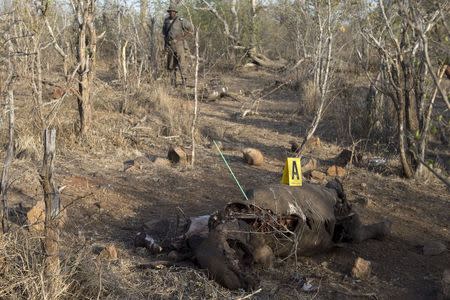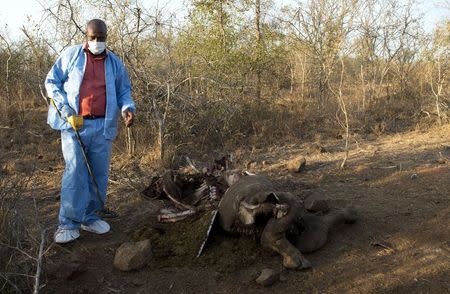CSI Kruger: forensic teams scour rhino killing scenes
By Ed Stoddard KRUGER NATIONAL PARK, South Africa (Reuters) - The killers struck under the light of a full moon, bringing their quarry down with a heavy caliber rifle at close range. The victim was a young black rhino in South Africa's Kruger National Park. The shots that rang out alerted rangers, who rushed to the area, killing one of the poachers in a shootout. The dead man's accomplices got away. Almost four days later, investigators - with a group of journalists in tow - arrived to collect DNA and other evidence to help trace the weapon and prove the origin of the horn sawn off for sale overseas. Such "crime scenes" have become common in Kruger, which is on the frontline of a surge in rhino poaching for the animal's horn to meet red-hot demand in counties such as Vietnam, where it is an ingredient in traditional medicine. According to government data, 1,215 rhino were poached in South Africa last year, almost triple the 448 killed in 2011. Of the 2014 total, 827 were killed in Kruger, which is home to around 9,000 of the animals. In Kruger, most rhino killings are treated like a crime scene and scoured by forensic experts. The scene that media were invited to this month was a few hundred meters off a dirt road in the bush, and not far from a perimeter fence - a poaching "hot spot". Most of the poachers come from neighboring Mozambique, one of the world's poorest nations which shares a 350-km (210-mile) border with Kruger, and also poor South African villages near the park - a reason why so much of the carnage takes place near the reserve's boundaries. The forensic work was undertaken by police surgeon Silence Mdluli, who wore a face mask and was clad in blue surgical overalls, and investigator Bella Khosa. The rotting corpse lay sprawled on its left side, its ribs picked clean by scavengers. The horn had been hacked off. The forensic team's work included taking tissue samples and cutting away a toenail for DNA analysis. "If we recover the horn, this can be matched to the DNA," Khosa explained. The corpse had been marked as "exhibit A", while exhibits "2" and "3" were a pair of shell casings, found only about 10 m away, which had been discharged from a .458 caliber rile - basically, an elephant gun. If it is ever retrieved, the shells could be matched to it. A metal detector was used on the corpse to see if a bullet was lodged inside, but none was found. Black rhinos are the rarer and smaller of Africa's two species of the pachyderm - the other being the white rhino - and this one's size, around 200 kg (440 lb), meant the bullet probably passed straight through its body. Mdluli also tied a plastic ribbon to the branch of a tree. "If a chopper sees the carcass, this will tell them it is a known crime scene," he said. Such investigations, combined with red-handed arrests made by rangers, are starting to yield results. In Mpumalanga province which borders Kruger, the conviction rate in rhino cases is currently 100 percent. (Editing by Michael Roddy and Alison Williams)


